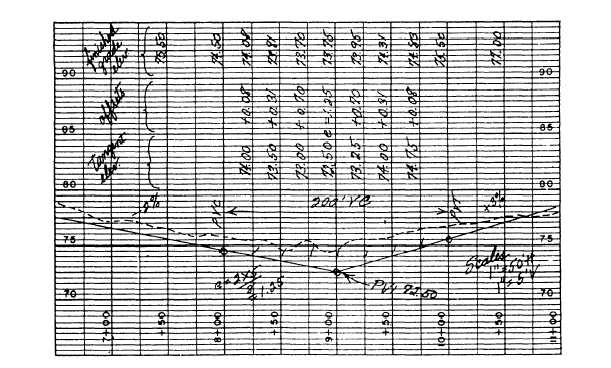vertical scale; that is, with the vertical scale perhaps
10 times the horizontal scale. After the POVCs have
been plotted, you should be able to draw a smooth
parabolic curve through the points with the help of a
ship’s curve or some other type of irregular curve; if
you can’t, check your computations.
USING A PROFILE WORK SHEET
After you have had some experience computing
curves using a table as shown in the foregoing
examples, you may wish to eliminate the table and
write your computations directly on a working print
of the profile. The engineer will set the grades and
indicate the length of the vertical curves. You may
then scale the PVI elevations and compute the grades
if the engineer has not done so. Then, using a
calculator, compute the POVT elevations at the
selected stations. You can store the computations in
some calculators. That allows you access to the
grades, the stations, and the elevations stored in the
calculator from one end of the profile to the other. You
can then check the calculator at each previously set
PVI elevation. Write the tangent elevation at each
station on the work sheet. Then compute each vertical
offset: mentally note the x/ 1 ratio; then square it and
multiply by e on your calculator. Write the offset on
the work print opposite the tangent elevation. Next,
add or subtract the offsets from the tangent elevations
(either mentally or on the calculator) to get the curve
elevations; then record them on the work sheet. Plot
the POVC elevations and draw in the curve. Last, put
the necessary information on the original tracing. The
information generally shown includes grades;
finished elevations; length of curve; location of PVC,
PVI, PVT, and the e. Figure 11-21 shows a portion of
a typical work sheet completed up to the point of
drawing the curve.
FIELD STAKEOUT OF
VERTICAL CURVES
The stakeout of a vertical curve consists basically
of marking the finished elevations in the field to guide
the construction personnel. The method of setting a
grade stake is the same whether it is on a tangent or on
a curve, so a vertical curve introduces no special
problem. As indicated before, stakes are sometimes
set closer together on a curve than on a tangent. But
that will usually have been foreseen, and the plans will
show the finished grade elevations at the required
stations. If, however, the field conditions do require a
stake at an odd plus on a curve, you may compute the
needed POVC elevation in the field using
given on the plans and the computational
explained in this chapter.
the data
methods
Figure 11-21.—Profile work sheet.
11-20

